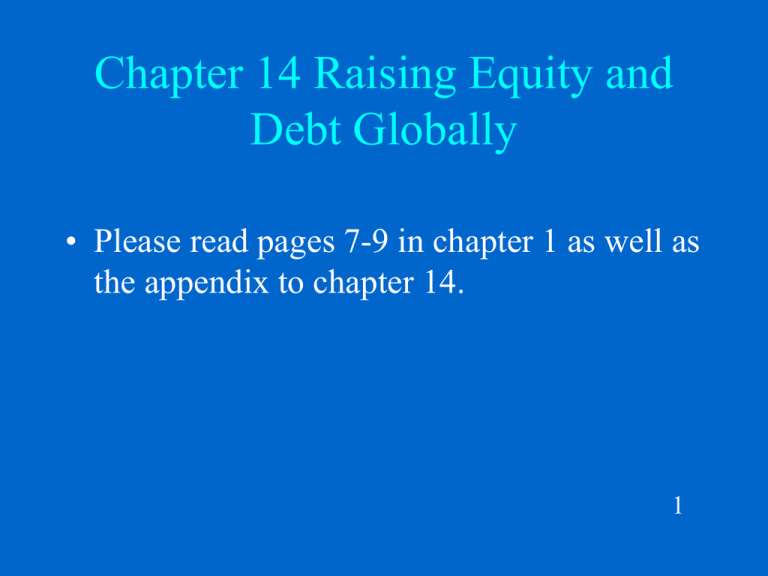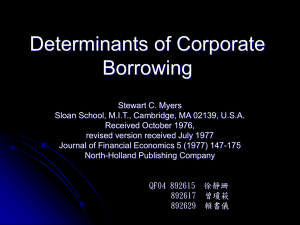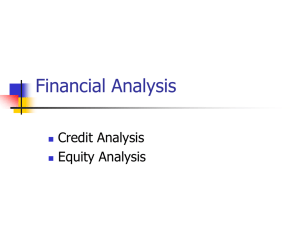Chapter 9 - Translation Exposure
advertisement

Chapter 14 Raising Equity and Debt Globally • Please read pages 7-9 in chapter 1 as well as the appendix to chapter 14. 1 OUTLINE FOR CHAPTER 14 • • • • Crosslisting ADRs Sourcing Equity Abroad Optimal Financial Structure Guidelines for issuing debt Overview of some international debt markets 2 Chapter 14 - Sourcing Equity Globally • Emphasis in this chapter are firms operating in less liquid or segmented markets • Often US and UK firms source overseas to fund large foreign acquisitions and not for their existing domestic or foreign operations 3 Crosslisting • Listing your company shares on a foreign market 4 Why Crosslist on Foreign Stock Exchanges • (1) Improve the liquidity for existing shareholders by letting them trade in their home markets and currencies • (2) Possibly have a favorable effect on share price if markets are segmented or illiquid 5 Why Crosslisting - Continued • (3) If a company wants to issue stock in the future in a particular market may want to crosslist now. • (4) Might help if trying to acquire firms in foreign markets (if pay in stock, not cash) 6 Why Crosslisting - Continued • (5) Increase firm’s visibility and political acceptance to customers, suppliers, creditors and local governments - if there is local ownership the firm may be more popular • (6) Create a secondary market for shares to reward employees 7 Barriers to Crosslisting • For non-U.S. firms the disclosure requirements for the SEC are tough and continuous • May also need a continual program of investor relations 8 ADRs • Crosslisting usually done through depositary receipts (shares). In U.S. foreign shares are usually traded as American depositary receipts (ADRs). When sold globally called Global Depository Receipts (GDRs) • Negotiable certificates issued by a U.S. bank to represent foreign stock which are held in trust in foreign bank 9 ADRs - Continued • ADRs represent some multiple of the foreign stock • ADRs sold, registered, and transferred in U.S. like any other stock • Dividends paid in U.S. dollars • Can be sponsored (created by request of foreign firm) or unsponsored (U.S. firm initiated process) 10 ADRs - Continued • Different levels of ADRs (see page 388) – Note with level III and 144A a firm can raise new equity capital 11 Major Markets to Crosslist New York Tokyo London Germany Euronest (merged markets of Amsterdam, Brussels, and Paris) 12 Sourcing New Equity Shares • Examples: (1) Sale of directed public share issue to investors in a foreign country. Would be underwritten in part by institutions in that country. 13 Sourcing New Equity Issues Continued (2) Sale of Euro-equity issues - firm issues shares simultaneously in more than one market (could be domestic as well as foreign). Underwritten by an international syndicate. Examples include some privatizations of government owned businesses (British Telecom, British Steel, and Telefonos de Mexico) and Gucci. 14 Sourcing New Equity Issues Continued • (3) Private Placement – Sales often to insurance and investment companies – For U.S., under Rule 144A, private placements are sales to qualified institutional buyers (nonbank firms) without SEC registration 15 Optimal Financial Structure • Generally argued that a moderate amount of debt is good (tax advantage) but too much debt is bad (bankruptcy risk) • Also WACC is effectively minimized over a range of debt (say 30% -60%) and not at some precise amount say 44 % 16 Optimal Financial Structure for Multinationals • From Chapter 11, one big advantage for U.S. multinationals or large non-U.S. multinationals is that they are able to raise “lots” of capital without the cost of these funds increasing much • This is not the case for small domestic firms and most multinationals operating in small or illiquid markets 17 Financial Risk Reduction through International Diversification • Possible to argue that multinationals can have more debt because their cash flows are more diversified and hence less bankruptcy risk • In reality, multinationals have less debt than comparable domestic firms after adjusting for size 18 Financial Structure for Foreign Affiliates • Goal for firm: minimize WACC for entire firm, not for each affiliate • Note when discussing debt for a subsidiary what is relevant is debt borrowed from sources outside of the multinational firm (not debt from the parent or sister affiliate. Also hard to distinguish between debt and equity from the parent) 19 Advantages to Conforming to Local D/E Ratios • Reduce criticism from local Government officials or from others (for example, too much debt or too little debt) • Easier to evaluate firm with local competitors when all firms have same capital structure 20 Disadvantage of Conforming to Local D/E Ratios • Multinational should exploit its advantages (one of them is its ability perhaps to have a lower cost of capital). If multinational tries to localize its cost of capital for each subsidiary, it may result in losing one of its key advantages 21 Conclusion - Local D/E Ratios • The firm should strive to have the lowest overall cost of capital for the firm as a whole • If there is no penalty for conforming to local norms, then the firm should try and do so 22 Guidelines for Issuing Debt • Maturity Matching – Firm divides its assets in three categories - (1) fixed assets, (2) permanent current assets (the minimum amount of current assets the firm has), and (3) temporary current assets (total current assets - permanent current assets) – In theory, could finance all fixed assets and permanent current assets with long-term debt and equity and temporary current assets with short-term debt (see diagram) 23 Maturity Matching - Continued – In general, short-term financing is cheaper (rates are generally cheaper and also firm does not have to pay interest when funds are not needed) – However, short-term financing is riskier (interest rate risk) – So firm may deviate from maturity matching depending on its return/risk tradeoffs (a conservative firm might use relatively more long-term financing) 24 Guidelines - Continued • Currency Matching - match by cash flows not denomination of assets – For example if the firm has a lot of cash flows in Euros then might consider borrowing in Euros 25 Cost of Foreign Debt • Discussed in Chapter 7 • Example - borrow 30 Pesos at 15%, spot rate Pesos 15/$ and expect future rate to be Pesos 16/$ • Cost in Dollars = (Pesos 30)(1.15)/(Pesos 16/$) $2 = $.15625 on a $2 loan or an interest rate of 7.8125% • This approach is equivalent to formula • (1 + i*) (1 + s) - 1 26 Cost of Foreign Debt - Continued • Where i* is the foreign interest rate s is the percentage change in the exchange rate • (1 + .15) (1 - .0625) - 1 = .078125 Note s = (15 - 16)/ (16) = -.0625 27 Cost of Foreign Debt - Continued • Interest payments are tax deductible in the U.S. • Cost of debt after tax = kd (1-T) Where kd is the before tax cost of debt T is the marginal tax rate for the firm 28 Digression - Eurocurrency or Eurodollar Market • A Eurodollar is a U.S. $ deposited in an interest bearing deposit in a bank outside of the U.S. (foreign bank, overseas branch of a U.S. bank, or an “offshore” entity called an International Banking Facility) • Same idea for Euroyen 29 Eurocurrency Market - Continued • Good market to deposit excess funds and also borrow funds. The market can do this because it is a wholesale market, no reserve requirements, and no FDIC (Federal Deposit Insurance Corporation) fees. Hence the spread (difference between borrowing and deposit rates) is often less than 1%, which is smaller than most domestic markets 30 Eurocurrency Market - Continued • The market originally started with Eastern European countries with dollars wanting to deposit them outside the control of the U.S. government • Also U.K. authorities worried about the weakening of the pound in 1957 imposed controls of U.K. banks lending pounds to non-residents, so U.K. banks started loaning dollars • Now a source and use of dollars 31 International Debt Markets • Three major sources – Bank Loans and syndicated credits – Euronote market – International bond market • Purpose of this section is to give an overview of these markets and not to provide all of the facts about each of the markets • Please read for more detail pages 418-423 32 International Bank Loans and Syndicated Credits • Eurocredits - Bank loans denominated in Eurocurrencies and given by banks in countries other than the country in which the loan is denominated (if the loan is in Yen the loan is not given in Japan) • Syndicated credits - Lending banks form a syndicate to diversify risk because size of loans is usually large 33 Eurocredits - Continued • Borrowing rate based on LIBOR (London Interbank Offered Rate) which is the deposit rate on interbank loans • Borrower pays LIBOR + individual premium • Loans have short and medium-term maturities • Usually fixed term and no provision for early repayment 34 Euronote Market • Important examples: Euronotes - short-term, negotiable, promissory, underwritten notes Euro-Commercial Paper – short-term debt obligation of a firm or bank Euro-Medium-Term Notes - mostly nonunderwritten and it is like a bond 35 International Bond Market • Two main types: Eurobonds Foreign bonds 36 Eurobonds • Underwritten by an international syndicate • Sold in countries other than the country in which the issue is denominated (example, English borrower, denominated in pounds, and sold everywhere but U.K.) • Bearer form (name and country of residence of the owner not on coupon) • Call provisions and sinking funds 37 Advantages of Eurobond Market • (1) Less regulatory interference (governments would impose less stringent requirements on bonds denominated in another currency) • (2) Less stringent disclosure requirements than SEC (less of a factor for private placements – Rule #144A) 38 Advantages - Continued • (3) Possible tax advantages - no withholding taxes and since bonds are in bearer form may result in tax avoidance 39 Foreign Bonds • Underwritten by syndicate composed of members from one country • Sold within that country • Denominated in that currency • Example: U.S. firm issues bond in pounds in U.K. and underwritten by a British syndicate 40









